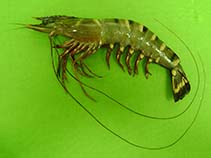Penaeus monodon Fabricius, 1798
Giant tiger prawn| Native range | All suitable habitat | Point map | Year 2050 |

|
| This map was computer-generated and has not yet been reviewed. |
| Penaeus monodon AquaMaps Data sources: GBIF OBIS |
Classification / Names Common names | Synonyms | CoL | ITIS | WoRMS
Malacostraca | Decapoda | Penaeidae
Environment: milieu / climate zone / depth range / distribution range Ecology
Benthic; brackish; depth range 0 - 150 m (Ref. 10), usually ? - 60 m (Ref. 10). Tropical; 17°C - 38°C (Ref. 72772), preferred 24°C (Ref. 107945); 36°N - 33°S, 55°E - 154°E
Distribution Countries | FAO areas | Ecosystems | Occurrences | Introductions
Indo-Pacific: From Pakistan to Japan, the Malay Archipelago and Australia. Introduced in the Atlantic Ocean (Africa and USA). Tropical to temperate.
Length at first maturity / Size / Weight / Age
Maturity: Lm ?, range 4 - 4.22 cm Max length : 33.6 cm TL male/unsexed; (Ref. 8); 35 cm TL (female); max. published weight: 250.00 g (Ref. 116487)
Short description Morphology
Uniformly glabrous body; carapace with well-developed antennal and hepatic spines. Horizontal and straight hepatic carina. Rostrum armed with 7 or 8 dorsal and 3 ventral teeth. Color: body is reddish with darker bands. Brown to blue pleopods and reddish fringing setae.
Caught by pond fishing and inshore fishing. Considered a delicacy in the Philippines that in 1980, retail price was Php60 to 80 (US$8.6 to 11.5)/kg in Manila and Php50 to 70 in local areas (Ref. 10). Maximum total length (female) from Ref. 104052.
Life cycle and mating behavior Maturity | Reproduction | Spawning | Eggs | Fecundity | Larvae
Members of the order Decapoda are mostly gonochoric. Mating behavior: Precopulatory courtship ritual is common (through olfactory and tactile cues); usually indirect sperm transfer.
Main reference
References | Coordinator | Collaborators
Holthuis, L.B. 1980. (Ref. 8)
IUCN Red List Status (Ref. 130435: Version 2024-1)
CITES status (Ref. 108899)
Not Evaluated
CMS (Ref. 116361)
Not Evaluated
Threat to humans
Human uses
Fisheries: commercial
FAO - Aquaculture: production, species profile; Fisheries: landings, species profile | FishSource | Sea Around Us
Tools
More information
Trophic Ecology
Ecology
Population dynamics
Life cycle
Human Related
Aquaculture profile
Stamps, Coins Misc.
Stamps, Coins Misc.
Outreach
References
Internet sources
BHL | BOLD Systems | CISTI | DiscoverLife | FAO(Aquaculture: species profile; Fisheries: species profile; publication : search) | Fishipedia | GenBank (genome, nucleotide) | GloBI | Gomexsi | Google Books | Google Scholar | Google | PubMed | Tree of Life | Wikipedia (Go, Search) | Zoological Record
Estimates based on models
Preferred temperature
(Ref. 115969): 24.7 - 29.1, mean 28.1 (based on 1984 cells).
Resilience
(Ref. 69278):
High, minimum population doubling time less than 15 months (K=0.94-1.7).
Prior r = 1.19, 95% CL = 0.79 - 1.79, Based on 4 data-limited stock assessments.
Nutrients : Calcium = 109 [35, 184] mg/100g; Iron = 1.59 [1.21, 1.97] mg/100g; Protein = 20.2 [19.2, 21.3] %; Omega3 = 0.285 [0.185, 0.386] g/100g; Selenium = 48.3 [-31.7, 128.3] μg/100g; VitaminA = 0 μg/100g; Zinc = 1.79 [1.17, 2.40] mg/100g (wet weight); based on nutrient studies.



